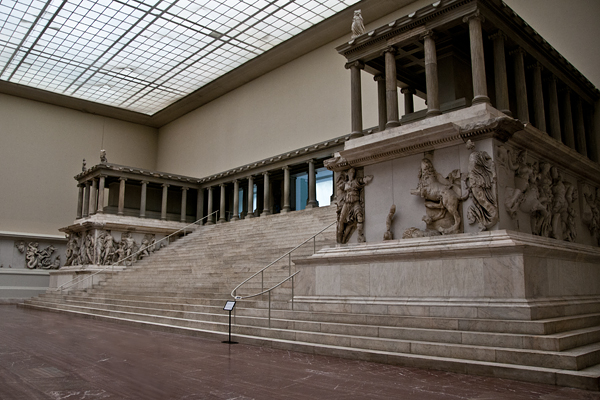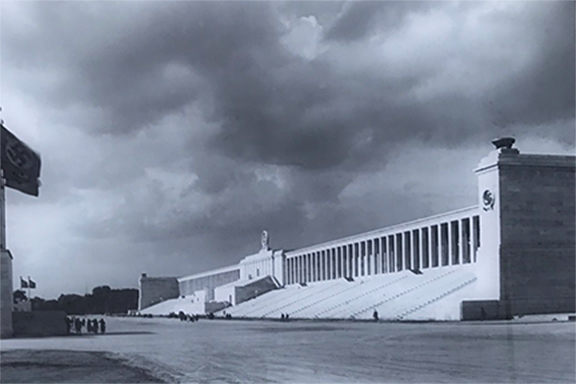The Great Altar of Zeus at Pergamon

"At Pergamon there is a large marble altar, forty feet high with massive sculptures; it also contains a gigantomachy [a battle between Giants and the Olympian gods].
Lucius Ampelius, Liber Memorialis (VIII.14)
This citation, the only one to reference the sculptures of the Altar of Zeus, is from a chapter on miracula mundi ("wonders of the world") and part of a handbook written, says the author in his preface, "so that you may know what the universe is, what the elements are, what planet Earth contains, and what the human race have accomplished." Now in the Pergamon Museum (Berlin), the Altar is the centerpiece of the museum that bears its name.

A better impression is conveyed by a model in the Pergamon Museum. Situated on a terrace just below the acropolis, the temple precinct (temenos) of Athena, the city's patron goddess, was surrounded on three sides by a stoa that was open on the western side to allow the temple to be better seen from the valley below. On a lower terrace was the Altar of Zeus.

Now, only a portion of the steps remain in place.
"And to the angel of the church in Pergamos write; These things saith he which hath the sharp sword with two edges; I know thy works, and where thous dwellest, even where Satan's seat is."
Revelation 2:12–13
In 1935, the Nazi architect Albert Speer began construction of a grandstand at the old Zeppelin airfield in Nuremburg, using as his model the Great Altar, which first had been exhibited just five years before. It was at the fifth rally of the Reich Party Congress in 1933, when Adolph Hitler came to power, that he declared that Nuremburg would henceforth be the site for the annual rally, which became increasingly more orchestrated and elaborate, culminating in the Party Congress of 1934 (chronicled by Leni Riefenstahl in her masterpiece of propaganda, Triumph of the Will). This picture was taken in 1938, the year after the so-called Zeppelintribüne had been completed.
Discovered at Pergamon (Bergama in northwest Turkey) in 1878, excavation of the Great Altar continued the next year, when the Ottoman government agreed to sell its one-third share of the ruins to the Antikensammlung Berlin (Berlin Antiquities Collection). Transported to the German capital, scenes from the Altar frieze were temporarily displayed in the Altes (Old) Museum and met with such enthusiasm that work continued until 1886. In 1901, the first Pergamonmuseum was built but, being inadequate for the display, was closed and demolished in 1908 in anticipation of a monumental new building. Construction began two years later, but the outbreak of World War I and ruinous inflation afterwards delayed its opening until 1930. With the start of World War II, the exhibition again was closed, having been open to the public for only nine years. By the beginning of 1941, the threat of bombing forced the removal of the frieze to a flak tower near the Berlin Zoo, the museum itself being partially destroyed in several air raids.
When the Soviet army captured the city in 1945, the panels of the frieze were appropriated as war booty and taken for storage at the Hermitage Museum in St. Petersburg. But they and the rest of the classical antiquities collection were restored to the museum in 1958, which was in the eastern sector of the city and then part of the German Democratic Republic and again put on display the next year. The Berlin Wall separating the city came down thirty years later (in 1989) and the Altar frieze itself completely restored between 1996 and 2004. Cement additions and rusted dowels were replaced and the frieze partially reconfigured. But then the exhibit again was closed in 2014 for more extensive restoration and refurbishment. Expected at the time to reopen in five years, costs almost have doubled and work now is not expected to be completed until 2027—or later still.
Pergamon (Pergamos) is the Greek spelling; Pergamum, the Latin.
References: Pergamon: The Telephos Frieze from the Great Altar (1996) edited by Renée Dreyfus and Ellen Schraudolph (exhibition catalog); "Pergamon in Early Christian Literature" (1998) by Adela Yarbro Collins, in Pergamon Citadel of the Gods: Archaeological Record, Literary Description, and Religious Development (1998) edited by Helmut Koester.
